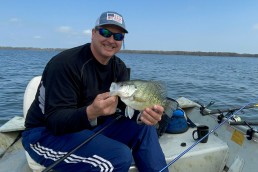Put Reelfoot Lake on Your Bucket List
SHARE THIS POST
Johnny Wilkins recommends adding Reelfoot—the “Quake Lake”—to your list of must visit places for great fishing and hunting in northwest Tennessee.
The region surrounding today’s Reelfoot Lake State Park was forever changed following several of the largest and most powerful earthquakes in history. Waves of ground dropped, forming a valley several miles long. The soil and trees sank 14 to 30 feet in some spots. The nearby Mississippi River was thrashed by sink holes and violent currents. The river actually ran backward for just over two hours, filling the Reelfoot swamp area to become an instant lake filled with flooded cypress trees.
Since cypress tree roots need air, these roots grew upward. Thousands of trees sticking out of the lake soon died in most cases. Local and state management eventually decided to saw the trees and attempt to sink them below water to make the lake better for boating. A dam was installed on one end to raise the water level.
What was left behind is a sanctuary for wildlife including bald eagles and osprey. The new submerged tree/water system became ideal for hunters and fishermen. The valley has four basins and plenty of fish habitat for crappies, catfish and bass, with plenty of spots for permanent hunting blinds sprinkled around the pristine state park.
The area includes several resorts. You might want to rent a boat instead of hauling yours. At certain times of the year, bumping stumps with your boat and motor results in bonus adventure. Tree trunks the size of dining room tables will throw you into caution mode! Fortunately, rentals are equipped for this type of rough-housing and motors are set to survive.
Abundant structure offers limitless hot spots spanning many different depths. The use of sonar is recommended to determine the areas and depths fish are at.
Local fishing rigs include a 2-ounce sinker at the bottom and a double-rigged crappie setup with two #6 hooks baited with minnows a short distance above. The local method is to put rod holders all over your boat and fish up to 30 lines! I did some experimenting and found that the local method is not great when the fish are not ultra-active.
Are you enjoying this post?
You can be among the first to get the latest info on where to go, what to use and how to use it!
I found that a subtler setup with a single hook worked better. I used a small crappie float and small shiner setup, using a #10 Owner hook about half the size of the wire hooks the locals were using. I also noted that the water was not that murky, and that adding premium fluorocarbon leader increased my catch.
The biggest crappies were taken on long crappie rods placed in rod holders screwed to the side of the boat. I used extra-small slip floats to get the depths right in water up to 14 feet. The float that scored the best was the Bobber Anne 3-inch size. The fish on this day were suspended at 10 feet and were mostly close to the submerged trees. The bite was very light; often, the slip float would barely go under. Light bites are the slip float’s specialty!
Boat control is big here. Two methods that you will have success with incorporate either using a good trolling motor anchoring on a long anchor rope. Basically, move upwind, pass over structure seen on your depth finder, and drop anchor. Then let the boat drift back onto the structure using a long anchor rope. This will prevent you from spooking fish. Watch your finder to let you know when to tie off and fish. Repeating this process provides a good workout with the anchor line.
Modern trolling motors networked with your GPS allow you to plot a path and then save it into your GPS. Slowly work your way through the submerged stump maze, inching your presentation forward.
Looking for someplace different to go hunting or fishing? Find plenty of suggestion in every issue of MidWest Outdoors, available by subscribing on our website.
MWO
SHARE THIS POST
You may also like...
Nothing found.
Did you enjoy this post?
You can be among the first to get the latest info on where to go, what to use and how to use it!
Johnny Wilkins
MidWest Outdoors works with more than 200 outdoor experts each year, who contribute articles based on their areas of expertise. MidWest Outdoors magazine offers more fishing and hunting articles than any other publication!
